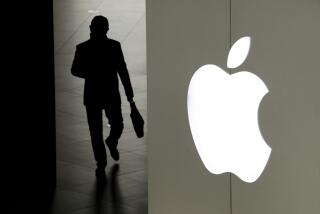Latest technology is at your fingertips
Apple Inc. engineers may have invented the perfect mousetrap.
The company made the computer mouse popular in 1984 with the release of the Macintosh. But its much-anticipated iPhone lets a finger that is whisked across a touch screen perform many of the same functions -- and new ones.
The iPhone combines a mobile phone, an iPod and a hand-held Internet device.
Showing it off at the Macworld conference in San Francisco last month, Jobs pinched his fingers together on the screen to shrink a photo, then spread them to expand it. He rolled his finger, and album covers shuffled past as if he were flipping through the vinyl at a record store. When he held the iPhone up to his face, the screen sensed him and went to sleep.
“When I don’t need my keyboard, it’s not there,” he said. “When I do, it’s there.”
The iPhone, which features a sleek screen that measures 3 1/2 inches by about 2 1/2 inches, marked a major advance in the commercialization of potent computers that use fingers on a screen to navigate.
Rudimentary touch screens have become commonplace, helping bank customers withdraw money from ATMs and travelers check in at airport kiosks. Researchers credit these machines for getting the public used to touching computer monitors, even as they dismiss them as “poking computer interfaces.”
In smart phones and other hand-held devices with small on-screen keypads, the plastic stylus became the pointer of choice. Apple spokeswoman Natalie Kerris dismissed the penlike pointer as “inconvenient” and “easy to lose.”
“It’s more natural to use the pointing device we were all born with -- your finger,” she said.
But for many years, researchers couldn’t master the finger. Their efforts to create sophisticated touch-screen computers were beset with technical challenges, high costs and doubts over whether consumers, trained to treat the mouse and keyboard as extensions of their hands, would adopt touch screens.
Not to mention the smudge factor from dirty digits.
But the growing popularity of smart phones, cost reductions and technological breakthroughs -- such as screens that don’t show the sensing mechanism underneath -- have spurred a potential boom in the touch-screen computer market. Researchers call these devices multi-touch, because the screens can process commands from several fingers at once.
“We’re at the appetizer stage of the multi-touch meal,” said John Feland, human interface architect at Synaptics Inc., a Santa Clara, Calif., interface designer that demonstrated its own multi-touch phone, the Onyx, in August.
When Apple’s iPhone goes on sale in June starting at $499, it may bring touch-screen devices into the mainstream and pave the way for competitors.
“The mouse caught on because people like to point,” said Fred Callopy, professor of information systems and cognitive science at Case Western Reserve University in Cleveland. “The new touch screens take a step in the direction of natural movement.”
Prada, the Italian fashion house, recently announced a multi-touch device. The Prada Phone, developed by South Korea’s LG Electronics with help from Synaptics, goes on sale in Europe this month for $775.
Microsoft Corp. has developed a technology called TouchLight, which has been compared to the way Tom Cruise’s character pushes images across a screen in the 2002 science fiction film “Minority Report.” EON Reality Inc., an Irvine interactive software company, licensed TouchLight with the intention of creating virtual 3-D modeling products for such industries as aerospace and auto manufacturing.
Hewlett-Packard Co. last week began selling its $1,799 TouchSmart PC, designed for use in the kitchen, living room and other family spaces. It includes a hideaway keyboard. But its touch screen enables users to perform tasks such as moving pictures and writing notes without having to sit at a desk, because that “feels like work,” said Julie McDonald, an industrial design product marketing manager at HP.
Touch screens have some drawbacks.
Cellphone users can feel the buttons when they dial. But with a touch-screen phone, dialers have to look down to check the virtual keypad as they enter a number.
One potential solution is the so-called haptics technology, which enables the computer screen to sense when it is being touched and respond by vibrating at different frequencies. So, to someone dialing a phone number, a 3 might feel different from a 9.
Another concern is ergonomics. The computer mouse triggered a rash of carpal tunnel syndrome. The mobile e-mail pager prompted “BlackBerry thumb.” Could the multi-touch cellphone spawn a new ailment of numb fingertips -- touch-screen finger?
Then there’s what researchers call the peanut butter factor -- dirt ruining or obscuring the screens. In most cases, developers say, smudges aren’t much of a problem because they’re rarely visible when the screen is on, and they’re easy to wipe away with common cleaning products.
Touch screens aren’t limited to mobile devices. Jefferson Han, a New York interface developer, is creating an interactive white board that can sense and take separate instructions from as many as 20 fingers at a time. His company, Perceptive Pixel Inc., aims to sell these screens to defense agencies and corporations.
His office phone started ringing after the iPhone launch. He’s heard from such potential clients as Hollywood studios, which are interested in a high-tech version of the giant storyboards, covered with sticky notes, that they use to organize scenes.
In the creative process, Han said, “you don’t want just one person to be the driver.”
But the regular mouse and keyboard will continue to work perfectly well for many computers.
Anthony Andre, a professor of human factors and ergonomics at San Jose State University, predicted that touch screens might become so trendy that developers include them in devices that don’t warrant them.
“Some products will come out and they shouldn’t have that interface,” he said. “It’s not always better to touch.”






